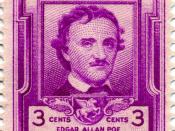Control or Insanity in Edgar Allen Poe's "The Tell-Tale Heart".
Poe weld's the full moon at midnight, like a beacon enlightening the truth that lies in the knowledge that madness is created by ones own inability to handle ones reality. When we try to define human nature, we must consider the balance of both good and evil. Many times these qualities exist simultaneously and maintain a balance, but sometimes this stability is lost and the evil side surfaces. In Edge Allen Poe's "The Tell-Tale Heart" possesses many elements attributed to the mentally unstable. Ironically, the greatest indication of sanity is the narrator's raging and deranged language as he attempts to prove his mental stability.
Have you ever wondered what it takes to push someone over the edge? The narrator's obsession with the old man's "Evil Eye"(1207) has driven him over that edge. His need to "rid myself of the eye for ever"(1206) was how he would regain control over his own mind.
But, one could argue that he was stable, due to the fact that it took him eight nights before he rid himself of the eye. He showed "caution-with what foresight"(1206) on how he went about to kill the old man. He was "never kinder to the old man"(1206) after he made up his "diseased mind" to kill the old man.
For seven long nights "at midnight, when the world slept,"(1207) the narrator would make "an opening sufficient for"(1206) his head. He did this with "cunning" and slowness, for not to awaken the old man. Yet, he needed to have the "Evil Eye" to be able "to do the work"(1207). Did the narrator profusely make noise on the eighth? One would think so, he chuckled and when he went to open the fastening. The...


